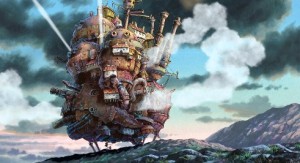 Is there a better animation director than Hayao Miyazaki? Could there be? It seems to me, for many reasons, that he’s the best in the world at what he does. Or what he did, I should say, because last year, to the consternation of his fans, he announced his retirement from filmmaking. Now, if you’re not familiar with his work, I encourage you to try any one of his many pictures. For example, there’s one from 2004 called Howl’s Moving Castle.
Is there a better animation director than Hayao Miyazaki? Could there be? It seems to me, for many reasons, that he’s the best in the world at what he does. Or what he did, I should say, because last year, to the consternation of his fans, he announced his retirement from filmmaking. Now, if you’re not familiar with his work, I encourage you to try any one of his many pictures. For example, there’s one from 2004 called Howl’s Moving Castle.
Howl’s Moving Castle sports an amazing visual technique accompanied by a story of childlike strangeness. The tale begins with a young woman named Sophie, working at a hat shop in an unnamed European-looking country that seems part old-fashioned turn-of-the-century and part futuristic. Sophie is transformed into an old woman by the spell of a crone called The Witch of the Waste, for reasons that—like much of the developments in this complex story—are not clear right away. In any case, she runs from her familiar home in fear and shame, only to find herself in a castle run by a handsome young sorcerer named Howl. The castle is a big claptrap affair that moves about on spindly mechanical legs. Furthermore, the entrance opens into different countries and realms depending on the turn of a dial above the doorway. Howl has some sort of dark secret, and he also has a young apprentice named Markl, and a fire-spirit named Calcifer who helps protect the castle.
Sophie settles into being an old woman–she seems to like the personal freedom the age affords her, although she does her share of grumbling—and goes about cleaning up the castle and taking care of Howl. They are all plunged into perilous adventures involving a plot by a sorcerer queen to defeat Howl.
Believe me, the plot is so weird that I haven’t even begun to explain it. There’s also a bouncing scarecrow with the head of a turnip, and a dog that wheezes when it tries to bark. We’ve become accustomed to having everything explained for us in children’s films (and in grown-up ones, too) but if you read The Brothers Grimm, or other fairy tales, you’ll see that the characters and stories are often ambiguous and elemental, carrying the weight of unspoken symbolic meanings, and following a logic of dreams and the unconscious rather than the orderly progression of rational thought. This is how Miyazaki’s films feel, and it’s a key to their power, even when the stories are adapted from other sources (this one’s based on a British teen novel by Diana Wynne Jones).
The animation, with its hand-drawn look and mind-boggling depth of detail, is spectacular. There’s so much visual splendor that at times it almost seems like overload. The ideas are remarkably adult, including a war theme that gets pretty scary–this is not a film for toddlers.
There’s also an emphasis on ordinary aspects of life, such as aging and housework, that is completely engaging. The fact that the heroine spends most of the picture as a little old lady certainly makes this story one-of-a-kind. Another interesting aspect is that everyone in the film is flawed and makes mistakes. The picture takes emotions seriously, and it respects the ability of children to experience profound feelings of sadness and loss as well as joy.
Howl’s Moving Castle is a dazzling and wonderful journey. It’s available on DVD.

